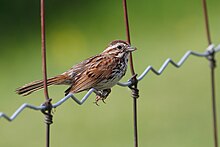Singing hammer
| Singing hammer | ||||||||||||
|---|---|---|---|---|---|---|---|---|---|---|---|---|

Song bammer ( Melospiza melodia ) |
||||||||||||
| Systematics | ||||||||||||
|
||||||||||||
| Scientific name | ||||||||||||
| Melospiza melodia | ||||||||||||
| ( Wilson , 1810) |

The song bunting ( Melospiza melodia ) is a North American songbird species that is divided into 31 subspecies.
features
The bird is brown on the top with dark stripes on the back and white on the underside with dark mottling and a dark spot on the chest. It has a brown hood and a long brown tail. The different subspecies differ in color from each other. The melodious and complex singing serves to defend the territory and to attract the female.
Occurrence
The bird lives in bushes and thickets near water, in swamps and salt marshes in large parts of Canada , the USA and northern Mexico . The birds from the northern range migrate to Mexico in the cold season. Few sightings have been reported from Norway and the UK . The Santa Barbara song bammer was endemic to the island of Santa Barbara Island off California and is now considered extinct.
behavior
This bird looks for insects and seeds on the ground, in the scrub or in shallow water. In salt marshes, crustaceans complement the diet.
Reproduction
The female builds a shell nest out of grass and stems on the ground in the thicket and incubates three to five eggs for about two weeks. The male helps raise the young, which fledge after two weeks, and takes care of the young a little longer while the female breeds again. Even three broods in a year are not uncommon.
literature
- Colin Harrison & Alan Greensmith: Birds. Dorling Kindersley Limited, London 1993, 2000, ISBN 3-831-00785-3
- Bryan Richard: Birds. Parragon, Bath, ISBN 1-405-45506-3
Web links
- Melospiza melodia in the endangered Red List species the IUCN 2008. Posted by: BirdLife International, 2008. Accessed January 31 of 2009.
- Videos, photos and sound recordings for Melospiza melodia in the Internet Bird Collection
- Feathers of singing bammer
